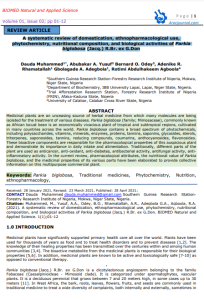Introduction
The proliferation of digital devices has fundamentally reshaped how users interact with websites and applications. A decade ago, websites were predominantly designed for desktop screens, and mobile users often experienced suboptimal layouts and navigation difficulties. With the rise of smartphones, tablets, and wearable devices, web content must now dynamically adapt to a wide variety of screen sizes, resolutions, and input mechanisms. Responsive design, first popularized by Ethan Marcotte in 2010, addresses these challenges by employing flexible grids, fluid images, and media queries to ensure websites provide consistent functionality and aesthetics across devices.
This article investigates the importance of responsive design in modern web development. It discusses current trends, technical methodologies, challenges, and applications in real-world scenarios, illustrating why responsive strategies are indispensable in a multi-device world.
Background and Context
Responsive design emerged as a solution to the fragmentation of device types and resolutions. Prior to its adoption, developers often created separate mobile sites or relied on static, fixed-width layouts, which were costly to maintain and offered inconsistent user experiences. The fundamental goal of responsive design is to create a single codebase capable of adapting to any device context.
Key components include:
-
Flexible Grids: Layouts based on relative units (percentages) rather than fixed pixels.
-
Fluid Images: Images that scale proportionally within parent containers.
-
Media Queries: CSS rules that adjust styling based on device characteristics such as width, height, and resolution.
Responsive design aligns closely with mobile-first principles, advocating for designing experiences for smaller screens first before scaling to desktops and larger displays. This approach enhances usability, reduces cognitive load, and prioritizes essential content for the most constrained environments.
Current Trends and Challenges
Trends
-
Mobile-First Development: A growing number of users access websites primarily via smartphones. Mobile-first design ensures core functionality is optimized for small screens.
-
Progressive Web Apps (PWAs): PWAs combine web and app functionality, benefiting from responsive layouts that seamlessly adjust to device contexts.
-
Adaptive Images and Lazy Loading: Techniques for optimizing performance without compromising responsive layouts.
-
Frameworks and Libraries: Bootstrap, Tailwind CSS, and Foundation streamline responsive development.
Challenges
-
Performance Optimization: Responsive sites can load additional CSS and JavaScript that may impact speed if not carefully optimized.
-
Cross-Browser Compatibility: Ensuring uniform behavior across multiple browsers remains a challenge due to inconsistent support for CSS and HTML features.
-
Balancing Aesthetics and Functionality: Maintaining visual design integrity while adapting to various screen sizes requires careful planning and testing.
-
Testing Across Devices: The sheer diversity of devices makes comprehensive testing resource-intensive.
Technical Analysis and Frameworks
Core Techniques
-
CSS Media Queries: Central to responsive design, allowing conditional styling based on device parameters.
-
Flexible Grid Systems: Using frameworks like Bootstrap’s 12-column grid to achieve fluid layouts.
-
Viewport Meta Tag: Enables scaling for mobile devices by controlling the viewport width.
-
Fluid Typography and Images: Using relative units (em, rem, %) to maintain proportional scaling across devices.
Tools and Methodologies
-
Responsive Design Testing Tools: BrowserStack, Responsinator, and Chrome DevTools allow developers to preview and debug layouts across devices.
-
Automated Performance Testing: Lighthouse and WebPageTest help optimize load times and identify responsive bottlenecks.
-
Component-Based Design: Libraries like React, Vue, and Angular facilitate modular, reusable UI elements adaptable to multiple devices.
Case Studies and Real-World Applications
-
Amazon: The e-commerce giant leverages responsive design to maintain a consistent shopping experience across desktops, smartphones, and tablets. Fluid grids and adaptive images enhance accessibility and usability.
-
BBC News: The news platform employs responsive layouts that adjust content hierarchy, ensuring readability and engagement across devices.
-
Airbnb: Utilizes component-based responsive design, providing seamless interaction for mobile bookings, desktop browsing, and tablet interfaces.
-
Starbucks: Implements responsive web design for mobile ordering, combining visual appeal with functional ease of use.
These examples demonstrate that responsive design is not merely aesthetic; it directly impacts engagement, conversion rates, and user retention.
Implications and Future Research Directions
Responsive design is increasingly intertwined with AI-driven adaptation, where layouts automatically adjust based on user behavior, device usage patterns, and accessibility needs. Future research may explore:
-
AI-Assisted Layouts: Predictive algorithms that adapt interfaces in real-time.
-
Automated Testing and Optimization: Tools that simulate multiple devices and network conditions to improve design efficiency.
-
Accessibility and Inclusive Design: Ensuring responsive frameworks account for diverse user abilities.
-
Integration with AR/VR Interfaces: Adapting responsive principles to immersive and multi-modal experiences.
By addressing these areas, responsive design can evolve beyond mere screen adaptation, becoming a fully intelligent and adaptive interface framework.
Conclusion
Responsive design is fundamental in a world dominated by multiple device types and user contexts. By implementing flexible layouts, adaptive images, and media queries, developers can provide consistent, high-quality experiences across screens. Beyond usability, responsive design enhances accessibility, supports mobile-first strategies, and positively affects user engagement and business outcomes. Future innovations, particularly in AI-assisted design, automated testing, and cross-platform integration, will further elevate the importance of responsive principles, ensuring that web applications remain user-centric, scalable, and sustainable in an increasingly complex digital landscape.
References
-
Marcotte, E. (2010). Responsive Web Design. A List Apart.
-
Wroblewski, L. (2011). Mobile First. A Book Apart.
-
Preece, J., Rogers, Y., & Sharp, H. (2015). Interaction Design: Beyond Human-Computer Interaction (4th ed.). Wiley.
-
Rouse, M. (2022). Responsive design. TechTarget. Retrieved from https://www.techtarget.com
-
Zeldman, J. (2014). Designing with Web Standards (3rd ed.). New Riders.








